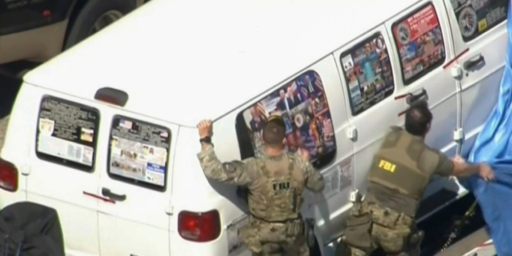Army Improves IED Training
Today, the U.S. Army is kicking off a massive new training program in an effort to reduce casualties caused by improvised explosive devices, or “IEDs.”
New Army program aims to put soldiers on higher alert for IEDs (Stars & Stripes)
American military officials have kicked off a new awareness campaign they hope will reduce deaths and injuries caused by the No. 1 killer of U.S. troops in Iraq: homemade bombs. Dubbed “5-and-25,†the program’s goal is, flatly, to “reduce the effectiveness of the mountain of makeshift bombs being produced by insurgents.â€
Improvised explosive devices, as the military has come to call them, have killed more than half of the U.S. casualties in Iraq. The bombs have been hidden in everything from plastic bags and tree trunks to dead animals. They have been remotely detonated. They have been put on timers. “IEDs are our No. 1 killers here,†Eric Egland, of the Joint IED Defeat Task Force, said in a release announcing the campaign.
The 5-and-25 refers to distances to “clear†any time a patrol or vehicle stops. Soldiers should look out for anything suspicious within a five-meter radius if they’re in a vehicle; if their vehicles stop, they should clear a 25-meter perimeter around the vehicles. In addition to bombs striking moving targets, patrols have been hit after being stationary for as little as four minutes, officials said. “Every time you stop outside a secure area, you always should check. Not checking could get you killed,†said Master Sgt. William Johnson, one of the designers of the campaign’s logo.
The concept has its roots in a similar technique developed by British forces operating in Northern Ireland, officials said. Military officials in Iraq say the new program was created because they were concerned that information wasn̢۪t getting to soldiers directly or quickly enough.
The campaign was timed to kick off Wednesday, or 5/25 on the calendar. Unfortunately, recent events will give it extra impact. At least 12 U.S. soldiers have been killed in the past two days, many of them by roadside bombs. In the past three weeks, at least 52 U.S. servicemembers have been killed in Iraq.
[…]
According to U.S. military officials, troops find and disable between 30 and 40 percent of roadside bombs before they detonate. Countermeasures of various kinds have been tried: observing via unmanned aerial vehicles, robot bomb-detectors and dogs. The military has also spent at least $460 million on electronic warfare systems designed to stop the explosions. There are currently six kinds of vehicle-mounted jamming devices in use; a total of 3,300 have been parceled out to forces in the Central Command area. “Unfortunately, no ‘silver bullet’ jammer exists,†the task force noted in an April report. U.S. military officials acknowledge there is no easy solution to the problem. But they hope the 5-and-25 campaign can help in some way.
While casualty rates attributed to makeshift bombs have been cut nearly in half in the last year, officials said, “as long as one soldier is killed or wounded, the command felt that it needed to do more.â€
Amen to that.






There were booby traps in Vietnam, but I’ve never heard of one yet in Iraq, only IEDs. What’s up with that?